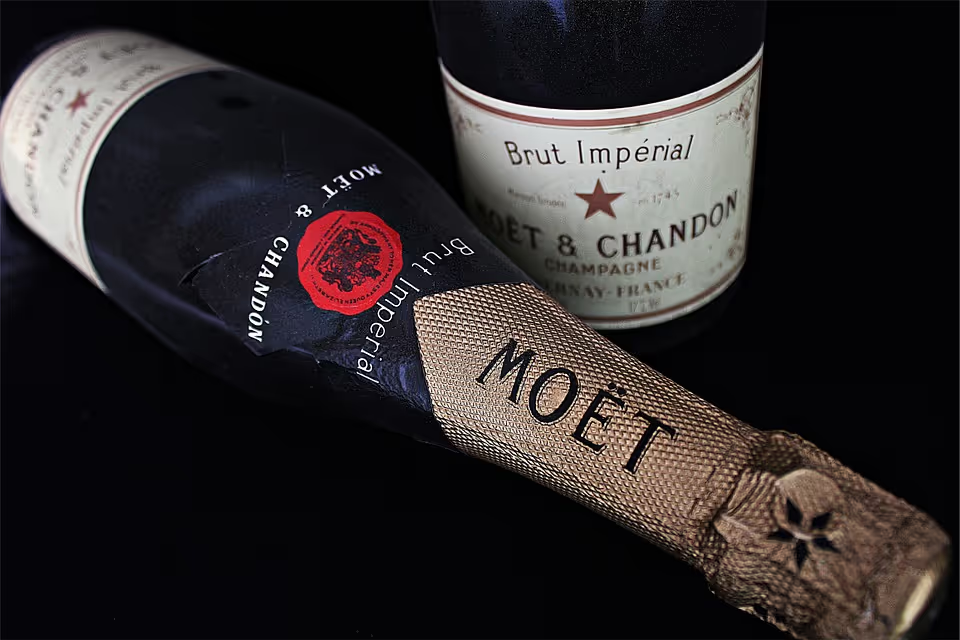Champagne: France's sparkling wine region

Sparkling wine with the trademarked name champagne is the epitome of a festive drink or an elegant gift all over the world. Big names such as Pommery, Moët & Chandon or Veuve Clicquot are synonymous with luxurious champagne enjoyment. In addition to these renowned champagne houses, there are also a number of unknown winemakers from the famous wine region of France. Learn more about traditional sparkling wines, grape varieties and award-winning top champagnes that inspire connoisseurs and investors alike.
From “unfinished wine” to luxury drink
It is said that the Romans were the first to grow grapes in Champagne. The wine they made from it was originally still. Until the Benedictine monk Dom Perignon In 1668, as a winemaker, began perfecting grape varieties and fermentation processes. He found that the blend of wines from different grapes, the so-called “cuvée”, guarantees the best quality. Over time, Dom Pérignon also succeeded in producing white wine from dark grapes. This was just as much a key moment in the history of champagne as the — originally unwanted — fermentation process. In the 17th century, wine had already begun to be bottled in the growing region, as the wine did not survive transport in the barrel well. However, due to early bottling, the wine continued to ferment unintentionally in the bottles. However, the resulting bubbles were still considered a flaw back then. Only the English enjoyed sparkling wine. This gave the champagne winemakers a new business idea that made the champagne trade flourish.
Until the 19th century, champagne remained cloudy because it was not possible to remove the dead yeast residues from the fermentation process. The idea for clarifying champagne came from Barbe-Nicole Clicquot-Ponsardin, wife and later widow of François Clicquot — the owner of a champagne cellar. Madame Clicquot (Veuve Clicquot, now a brand of the Moët Hennessy Louis Vuitton Group) developed “shaking” together with their German-born winemaker Antoine Müller and Alfred Werlé: A process that still exists today to remove yeast residues from the bottle without losing carbon dioxide.
By the way, the world-famous champagne brand Dom Pérignon owes its popularity to James Bond, who loved luxury bubbly. His legendary sentence from the bond film Goldfinger (1964) has gone down in champagne history: “For example, you never drink a 53 Dom Pérignon if it has a temperature above eight degrees. That would be just like listening to The Beatles without earmuffs!” He was obviously not a Beatles fan.
Champagne: Only genuine champagne
However, not every sparkling wine may be labelled champagne: The French name “Champagne” has been used in France since June 29, 1936 as an Appellation d'Origine Contrôlée by the Institut National de l'Origine et de la Qualité (INAO) protected. According to German food law, other sparkling wines must be referred to as sparkling wine, depending on the production and country of origin. A very logical decision, because the special soils and climate conditions of Champagne produce special, incomparable vines.
The historic province in northeastern France is now part of the Grand Est region and is located 150 kilometers northeast of Paris. It comprises 319 municipalities in five departments: Marne, Aisne, Aube, Haute-Marne and Seine-et-Marne. There, a maximum of 34,200 hectares can be planted with vines, making Champagne a relatively small wine-growing region in France. It covers only around three percent of the country's total wine-growing area. The vineyard area is spread over the four regions Montagne de Reims, Vallée de la Marne, Côte des Blancs and Côte des Bar. 61 villages may carry the “Grand Cru” or “Premier Cru” seal of approval. In order for a champagne to be officially referred to as Premier Cru or Grand Cru, only grapes classified accordingly must be used for production. However, you will hardly find these top classifications among the big, world-famous champagne brands. Because the quantity of first-class grapes for Premier Cru or Grand Cru is very limited, which is why particularly fine champagnes usually come from small, specialized winemakers.
Special conditions for a special touch
Located between 48° and 49.5° northern latitude, Champagne is located on the northern border of viticulture. Since the average annual temperature is only 10°C, the Champagne vines must produce the best grapes in a harsh climate.
The terroir consists primarily of limestone. By way of comparison, the average percentage of chalk in soil worldwide is seven percent and in Champagne 55 percent. This substrate has a positive effect on soil drainage and at the same time results in the unmistakable mineral note of many champagnes.
The largest wineries are indeed located in the cities of Reims and Épernay. However, the Verzenay and Bouzy-Ambonnay regions in the eastern and southern parts of the Montagne de Reims, the Côte des Blancs with the towns of Avize and Oger and the Grande Vallée de la Marne around Aÿ are considered to be the heart of the wine-growing region with the best locations.
Small region, big volumes
The Côte des Blancs alone has six of the 17 Grand Cru villages in Champagne and several outstanding Premier Cru growing areas. The Grand Cru villages are Chouilly, Oiry, Cramant, Avize, Oger and: Le Mesnil-sur-Oger. The small community is one of the most famous wine regions in Champagne and is particularly known for the excellent quality of Chardonnay.
The house is one of the most renowned champagne winemakers in this town saloon, which has a special position in every respect in the entire region: Salon only produces a single champagne, only in the best vintages and only from Chardonnay grapes. These come from a one-hectare plot owned by Salon — the “Jardin de Salon” — as well as 19 other small plots of land in Mesnil-sur-Oger. For around 100 years, Salon's goal has been to produce the best and most exclusive champagne, which is bottled in very limited quantities and is loved and sought after as a rarity by experts and investors alike.



